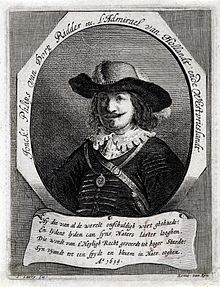Philips van Dorp
Philips van Dorp , also Filips, (* 1587 in Tholen , † 1652 in The Hague ) was a Dutch admiral.
He came from a noble family who were also related to the Orange and who were also related to the first admiral of Zeeland Willem Bloys von Treslong . In 1621 van Dorp became captain of the Admiralty of Zeeland. He was in the Mediterranean under Admiral Jochem Swartenhondt . In 1622 he became vice admiral. He took part in the blockade of Dunkirk, a nest of pirates, and received an award in 1624 for his bravery in fighting pirates from Dunkirk (under Michiel Colaert) in a convoy. In 1625 he took part in the blockade of La Rochelle under Willem de Zoete , for which the French king made him Knight of St. Michel. After de Zoete left in 1627, he became Lieutenant-Admiral of Zeeland. He was also accepted into the knighthood of the nobles of Holland.
Van Dorp was controversial. He was sometimes seen as undecided, arrogant and opinionated, and there were doubts about his competence. When fishermen protested in Vlissingen and Veere against the high losses caused by pirates in Dunkirk, he replied so condescendingly that he was pelted with stones in Veere. Since he did too little to protect Piet Pieterszoon Heyn , who was returning from the Caribbean with his booty from the attack on the Spanish silver fleet, in 1628 , he was released. Instead, Piet Heyn became Lieutenant-Admiral of Holland and West Friesland and thus commander of the fleet. When Heyn died in 1629, van Dorp became commander again, but despite his efforts (1630) did not get his rank as lieutenant admiral (or vice admiral) of Zeeland back. In 1632 he became lieutenant-admiral of Holland and West Friesland thanks to his connections to Friedrich Heinrich von Orange. In 1635 he was on an expedition in Spain when pirates from Dunkirk decimated the herring fleet in the North Sea without succeeding in punitive action, which also earned him criticism from Maarten Tromp and others (he also fell out with Witte de With ). Tromp was favored by many in the Admiralty as his successor, but had temporarily left the navy (also because he did not want to serve under Van Dorp) to organize private auxiliary fleets for war purposes.
In 1636 van Dorp allowed the English to blackmail the Dutch herring fleet with licenses and in 1637 the blockade of Dunkirk failed. He had problems with the supply of the fleet and had to break off the blockade of Dunkirk and return to the Netherlands. The Spaniards used this to land troops and undertake pirate trips against Dutch ships. The Admiralty had had enough and he was dismissed in favor of Tromp. To compensate, Friedrich Heinrich von Oranien appointed him a member of the council of the Admiralty of the Meuse in 1642. However, friction with Tromp continued. When Tromp proposed in 1647 that the former flagship Princess Aemilia be sold in order to have money for a new one (for which he otherwise received no funds), van Dorp railed that he would have preferred to see Tromp would have gone down with Princess Aemilia. Most recently, van Dorp was part of the Orange circle around Amalie von Solms in The Hague.
He was married to Sara von Baerle and had three daughters.
Web links
| personal data | |
|---|---|
| SURNAME | Dorp, Philips van |
| ALTERNATIVE NAMES | Dorp, Filips van |
| BRIEF DESCRIPTION | Dutch admiral |
| DATE OF BIRTH | 1587 |
| PLACE OF BIRTH | Tholen |
| DATE OF DEATH | 1652 |
| Place of death | The hague |
